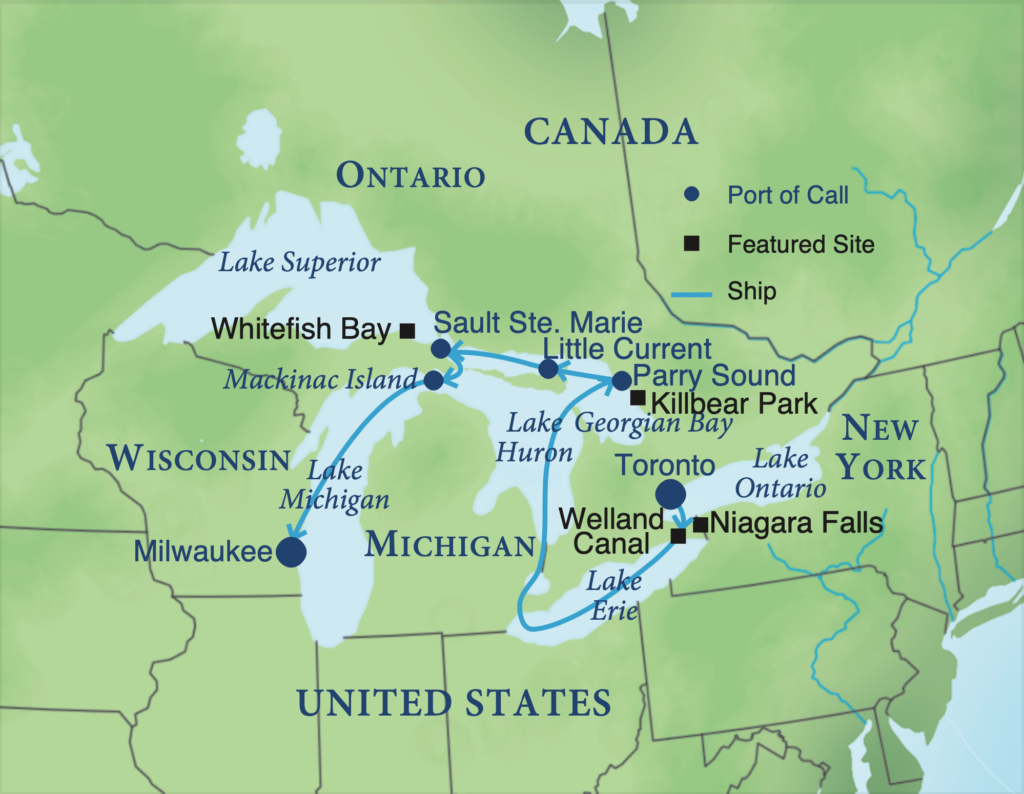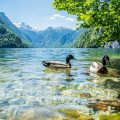The Great Lakes, a collection of five majestic bodies of water, are a prominent feature of North America’s physical and cultural heritage. These lakes, from west to east, are known as Superior, Michigan, Huron, Erie, and Ontario. Ranking them by size, Lake Superior takes the crown as the largest, covering an impressive area of 31,700 square miles.
The Great Lakes, collectively, form the largest freshwater system in the world. With a total surface area of 94,600 square miles, they are a remarkable natural wonder. What makes them even more fascinating is the fact that they are all interconnected by a network of lakes and rivers.
Lake Ontario, with a size of 7,340 square miles, is the smallest among the Great Lakes. Next up is Lake Erie, spanning 9,910 square miles, followed by Lake Michigan, which covers 22,404 square miles. Lake Huron, with an area of 23,007 square miles, comes in fourth. the mighty Lake Superior dominates them all with its vast expanse.
Each of the Great Lakes has its unique characteristics and attractions. Lake Superior, being the largest, offers awe-inspiring views and is renowned for its pristine beauty. It is a paradise for nature lovers, with its rugged shoreline, picturesque islands, and crystal-clear waters. The rugged beauty of this lake attracts visitors from around the world, who come to explore its majestic cliffs, lighthouses, and breathtaking waterfalls.
Lake Huron, the second-largest lake, boasts a diverse coastline dotted with charming beach towns. It offers a haven for boating, fishing, and water sports enthusiasts. Its stunning sunsets and sandy beaches make it a popular vacation destination for families and beachgoers.
Lake Michigan, though smaller than Lake Huron and Superior, still impresses with its immense size. This lake is known for its picturesque dunes, charming coastal towns, and vibrant cultural scene. Visitors can enjoy swimming, sailing, and fishing in its inviting waters, or explore the cultural attractions and vibrant cities that surround its shores.
Lake Erie, the fourth-largest Great Lake, is famous for its excellent fishing opportunities. It is a haven for anglers, offering an abundance of walleye, bass, and perch. The lake is also a popular destination for boating and water sports, with its shallow waters providing ideal conditions for sailing and jet skiing.
Lastly, Lake Ontario, the smallest of the Great Lakes, still holds its own charm and allure. It provides a picturesque setting for outdoor activities such as boating, kayaking, and windsurfing. The lake’s lively waterfront cities, such as Toronto and Rochester, offer a vibrant cultural scene and a variety of attractions for visitors to enjoy.
The Great Lakes are not only a marvel of nature but also a significant part of North America’s heritage. Their vastness and beauty attract millions of visitors each year, offering a plethora of recreational activities and breathtaking sights. Whether you seek adventure, relaxation, or simply a connection with nature, the Great Lakes have something to offer for everyone.

What Are The 5 Great Lakes Called?
The five great lakes are commonly referred to as Superior, Michigan, Huron, Erie, and Ontario. These lakes are located in North America and hold significant importance in terms of both physical and cultural heritage. Here is a breakdown of each lake:
1. Lake Superior: Situated at the westernmost point, Lake Superior is the largest of the five great lakes by surface area. It borders both the United States and Canada and is known for its breathtaking natural beauty, rugged shorelines, and numerous islands.
2. Lake Michigan: Located to the south of Lake Superior, Lake Michigan is the only great lake that lies entirely within the United States. It is the second-largest of the five lakes and offers a diverse range of recreational activities such as boating, fishing, and swimming.
3. Lake Huron: To the east of Lake Michigan, Lake Huron is the third-largest of the great lakes. It is connected to Lake Michigan through the Straits of Mackinac. This lake is known for its stunning shoreline, picturesque islands, and rich maritime history.
4. Lake Erie: Situated to the southeast of Lake Huron, Lake Erie is the fourth-largest of the great lakes. It is the shallowest and warmest of the five lakes, making it a popular destination for water sports and recreational activities. Lake Erie is also renowned for its vibrant fishing industry.
5. Lake Ontario: Located at the easternmost point, Lake Ontario is the smallest in surface area of the five great lakes. It serves as the outlet for the other lakes, as water from Lake Ontario flows into the St. Lawrence River. Lake Ontario offers a variety of recreational opportunities, including boating, fishing, and beach activities.
These great lakes collectively form a significant part of North America’s natural landscape and provide a multitude of opportunities for outdoor enthusiasts, historians, and those seeking serene natural beauty.
What Are The 5 Great Lakes In Order Of Size?
The five Great Lakes, listed in order of size from smallest to largest, are:
1. Lake Ontario: Covering an area of 7,340 square miles, Lake Ontario is the smallest of the Great Lakes. It is bordered by the Canadian province of Ontario to the north and the U.S. state of New York to the south.
2. Lake Erie: With a surface area of 9,910 square miles, Lake Erie is the fourth largest of the Great Lakes. It is situated between the Canadian province of Ontario and the U.S. states of Michigan, Ohio, Pennsylvania, and New York.
3. Lake Michigan: Spanning an area of 22,404 square miles, Lake Michigan is the third largest of the Great Lakes. It is entirely located within the United States, bordered by the states of Michigan, Indiana, Illinois, and Wisconsin.
4. Lake Huron: Covering an expanse of 23,007 square miles, Lake Huron is the second largest of the Great Lakes. It is situated between the Canadian province of Ontario and the U.S. state of Michigan.
5. Lake Superior: The largest and most expansive of the Great Lakes, Lake Superior spans an impressive 31,700 square miles. It is shared between the Canadian province of Ontario and the U.S. states of Minnesota, Wisconsin, and Michigan.
Are There 5 Or 7 Great Lakes?
There are five Great Lakes: Superior, Huron, Michigan, Erie, and Ontario. These lakes are collectively known as the Great Lakes and are the largest freshwater system in the world. Each of these lakes has its own unique characteristics and features. Let’s take a closer look at each of the Great Lakes:
1. Lake Superior: With a surface area of approximately 31,700 square miles, Lake Superior is the largest of the Great Lakes. It is also the deepest, reaching a maximum depth of 1,333 feet. Lake Superior is located between the United States and Canada.
2. Lake Huron: With a surface area of about 23,000 square miles, Lake Huron is the second-largest of the Great Lakes. It is connected to Lake Superior through the St. Marys River and is bordered by the United States and Canada. Lake Huron has many beautiful islands, including Manitoulin Island, the largest freshwater island in the world.
3. Lake Michigan: Lake Michigan has a surface area of around 22,400 square miles. It is connected to Lake Huron through the Straits of Mackinac. Lake Michigan is entirely located within the United States and is famous for its sandy beaches and stunning sunsets.
4. Lake Erie: With a surface area of approximately 9,900 square miles, Lake Erie is the fourth-largest of the Great Lakes. It is the shallowest and warmest of the lakes, making it a popular destination for boating, fishing, and swimming. Lake Erie is located between the United States and Canada.
5. Lake Ontario: Lake Ontario has a surface area of about 7,340 square miles and is the smallest of the Great Lakes. It is connected to Lake Erie through the Niagara River and is bordered by the United States and Canada. Lake Ontario is known for its beautiful shoreline, including the famous Niagara Falls.
There are indeed five Great Lakes: Superior, Huron, Michigan, Erie, and Ontario. These lakes form the largest freshwater system in the world and provide a variety of recreational opportunities, as well as serving as important waterways for transportation and commerce.
What Are The Five Great Lakes From Largest To Smallest?
The Great Lakes, a group of interconnected freshwater lakes located in North America, consist of five main lakes. These lakes vary in size, with Lake Superior being the largest and Lake Ontario being the smallest. Here is a detailed list of the Great Lakes ranked from largest to smallest:
1. Lake Superior: As the largest of the Great Lakes, Lake Superior spans an impressive area of approximately 31,700 square miles. It is located between the United States and Canada, with the majority of its surface area lying within the borders of the United States. Lake Superior is known for its deep blue waters, stunning cliffs, and numerous islands.
2. Lake Huron: Following Lake Superior in size is Lake Huron, which covers an area of approximately 23,000 square miles. This lake is also shared by the United States and Canada and is connected to Lake Michigan through the Straits of Mackinac. Lake Huron is famous for its scenic shoreline, sandy beaches, and picturesque lighthouses.
3. Lake Michigan: As the third largest Great Lake, Lake Michigan spans an area of around 22,400 square miles. It is entirely located within the United States, bordering the states of Michigan, Indiana, Illinois, and Wisconsin. Lake Michigan is renowned for its vibrant coastal cities, stunning sand dunes, and recreational activities such as boating, fishing, and swimming.
4. Lake Erie: Following Lake Michigan is Lake Erie, which covers an area of approximately 9,900 square miles. It is the fourth largest of the Great Lakes and is situated on the border between the United States and Canada. Lake Erie is known for its shallow depth, making it the warmest and most biologically productive of all the Great Lakes. It is a popular destination for fishing, boating, and birdwatching.
5. Lake Ontario: Lastly, Lake Ontario is the smallest of the Great Lakes, spanning an area of approximately 7,300 square miles. It is located on the border between the United States and Canada, with the majority of its surface area lying within the province of Ontario, Canada. Lake Ontario is famous for its stunning waterfront cities, beautiful beaches, and the renowned Niagara Falls, which it shares with Lake Erie.
The Great Lakes, ranked from largest to smallest, are Lake Superior, Lake Huron, Lake Michigan, Lake Erie, and Lake Ontario. These lakes offer a diverse range of natural beauty, recreational activities, and cultural attractions, making them a popular destination for visitors from around the world.
Conclusion
The Five Great Lakes – Superior, Huron, Michigan, Erie, and Ontario – are not only geographical wonders but also hold immense cultural and historical significance. Lake Superior stands as the largest of the Great Lakes, covering an impressive area of 31,700 square miles. It is followed by Lake Huron, Lake Michigan, Lake Erie, and Lake Ontario, each offering its own unique features and attractions.
These Great Lakes collectively form the largest freshwater system in the world, spanning a total surface area of 94,600 square miles. Their interconnectedness through various lakes and rivers creates a magnificent ecosystem that supports diverse flora and fauna. The Great Lakes play a crucial role in providing drinking water, transportation routes, and recreational opportunities for millions of people.
Aside from their natural beauty, the Great Lakes have a rich cultural heritage. They have been a vital resource for indigenous tribes, early European settlers, and the development of industry in the region. The lakes have witnessed significant historical events, such as battles during the War of 1812 and the growth of major cities like Chicago and Toronto along their shores.
The Great Lakes continue to be a popular destination for outdoor enthusiasts, offering activities like boating, fishing, swimming, and hiking. They provide breathtaking views, sandy beaches, and countless opportunities for relaxation and adventure.
In essence, the Five Great Lakes are not just bodies of water, but symbols of the power and beauty of nature. Their vast size, ecological importance, and historical significance make them truly remarkable. As we continue to appreciate and preserve these natural wonders, we ensure that future generations can also experience the awe-inspiring magnificence of the Great Lakes.












